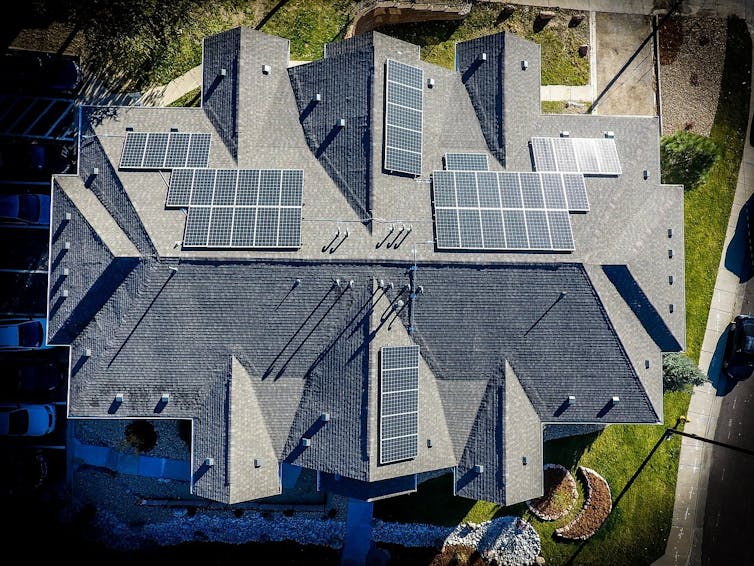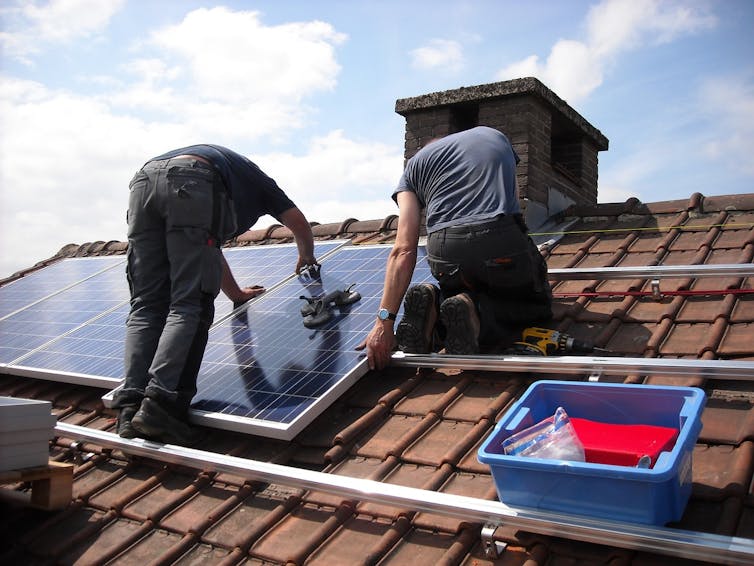The main purpose of this ongoing blog will be to track planetary extreme or record temperatures related to climate change. Any reports I see of ETs will be listed below the main topic of the day. I’ll refer to extreme or record temperatures as ETs (not extraterrestrials).😉
Main Topic: Just Requiring Solar Panels On All Roofs Would Solve Our Energy Problems
Dear Diary. This good news is no joke. Our civilization doesn’t really need huge solar panel or wind farms, or more nuclear power plants to power everything to save our climate and coastal cities. All we need to do is require by law worldwide that modern solar panels be attached to all rooftops and eureka, we will have all the electric power necessary to power everything, including electric vehicles.
This means we won’t need to denude large tracks of land for power of any kind. We will be able to leave all fossil fuels in the ground. And yes, existing wind and solar farms will be a bonus, adding to our power supply.
We should demand that all structures with roofs get solar panels, and that governments should help to subsidize these. Of course, most people can’t afford the added burden to transform their houses to all electric dwellings powered by solar panels, and in some locations on the planet it’s too cloudy, or during winter there is not enough sunlight to utilize solar power. Those locations will need power from large battery facilities where power can be stored during months when sunlight is plentiful. Governments should offer to help with all transformations with subsequent plans after those like Build Back Better are implemented.
For more details read the following Conversation piece:

Covering roofs with solar panels could significantly contribute to decarbonising global energy systems. MaddyBris/Pixabay
Solar panels on half the world’s roofs could meet its entire electricity demand – new research
October 11, 2021 12.17pm EDT
Rooftop solar panels are up to 79% cheaper than they were in 2010. These plummeting costs have made rooftop solar photovoltaics even more attractive to households and businesses who want to reduce their reliance on electricity grids while reducing their carbon footprints.
But are there enough rooftop surfaces for this technology to generate affordable, low-carbon energy for everyone who needs it? After all, it’s not just people who own their own houses and want to cut their bills who are in need of solutions like this. Around 800 million people globally go without proper access to electricity.
Our new paper in Nature Communications presents a global assessment of how many rooftop solar panels we’d need to generate enough renewable energy for the whole world – and where we’d need to put them. Our study is the first to provide such a detailed map of global rooftop solar potential, assessing rooftop area and sunlight cover at scales all the way from cities to continents.
We found that we would only need 50% of the world’s rooftops to be covered with solar panels in order to deliver enough electricity to meet the world’s yearly needs.
We designed a programme that incorporated data from over 300 million buildings and analysed 130 million km² of land – almost the entire land surface area of the planet. This estimated how much energy could be produced from the 0.2 million km² of rooftops present on that land, an area roughly the same size as the UK.
We then calculated electricity generation potentials from these rooftops by looking at their location. Generally, rooftops located in higher latitudes such as in northern Europe or Canada can vary by as much as 40% in their generation potential across the year, due to big differences in sunshine between winter and summer. Rooftops near the equator, however, usually only vary in generation potential by around 1% across the seasons, as sunshine is much more consistent.

This is important because these large variations in monthly potential can have a significant impact on the reliability of solar-powered electricity in that region. That means places where sunlight is more irregular require energy storage solutions – increasing electricity costs.
Hotspots
Our results highlighted three potential hotspots for rooftop solar energy generation: Asia, Europe and North America.
Of these, Asia looks like the cheapest location to install panels, where – in countries like India and China – one kilowatt hour (kWh) of electricity, or approximately 48 hours of using your laptop, can be produced for just 0.05p. This is thanks to cheap panel manufacturing costs, as well as sunnier climates.
Meanwhile, the costliest countries for implementing rooftop solar are USA, Japan and the UK. Europe holds the middle ground, with average costs across the continent of around 0.096p per kWh.
Rooftop solar panels look like they’d be equally useful in areas with low population as they would be in urban centres. For those living in remote areas, panels help top up or even replace supply from potentially unreliable local grids. And for those in cities, panels can significantly reduce air pollution caused by burning fossil fuels for energy.

It’s vital to point out that global electricity supply cannot rely on a single source of generation to meet the requirements of billions of people. And, thanks to changeable weather and our planet’s day and night cycle, a mismatch between solar energy demand and supply is unavoidable.
The equipment required to store solar power for when it’s needed is still extremely expensive. Additionally, solar panels won’t be able to deliver enough power for some industries. Heavy manufacturing and metal processing, for example, require very large currents and specialised electricity delivery, which solar power won’t yet be able to provide.
Despite this, rooftop solar has huge potential to alleviate energy poverty and put clean, pollution-free power back in the hands of consumers worldwide. If the costs of solar power continue to decrease, rooftop panels could be one of the best tools yet to decarbonise our electricity supply.
How The Conversation is different
Every article you read here is written by university scholars and researchers with deep expertise in their subjects, sharing their knowledge in their own words. We don’t oversimplify complicated issues, but we do explain and clarify. We believe bringing the voices of experts into the public discourse is good for democracy.
Beth Daley

Editor and General Manager
Related:
Here are some “ET’s”*reported on Wednesday:
Here is some more September 2021 climatology:
Here is more climate and weather news from Wednesday:
(As usual, this will be a fluid post in which more information gets added during the day as it crosses my radar, crediting all who have put it on-line. Items will be archived on this site for posterity. In most instances click on the pictures of each tweet to see each article. The most noteworthy items will be listed first.)
Now here are some of today’s articles and notes on the horrid COVID-19 pandemic:
(If you like these posts and my work please contribute via the PayPal widget, which has recently been added to this site. Thanks in advance for any support.)
Guy Walton “The Climate Guy”